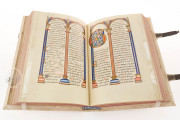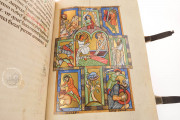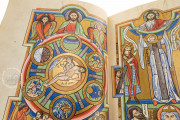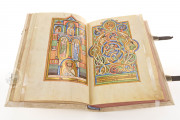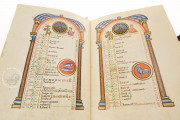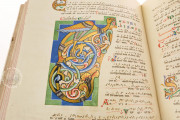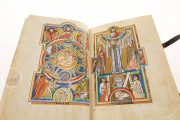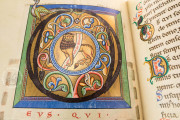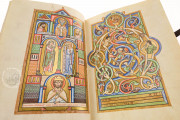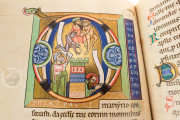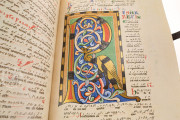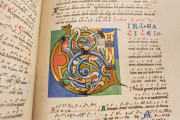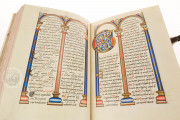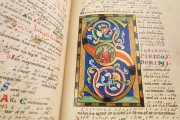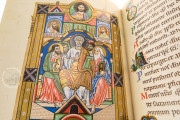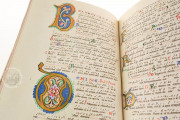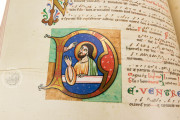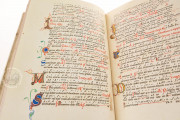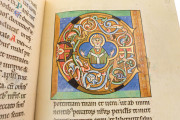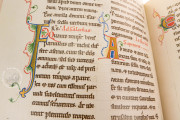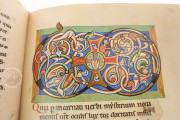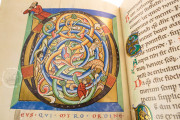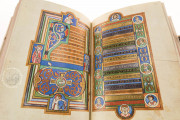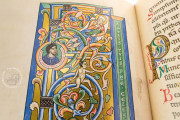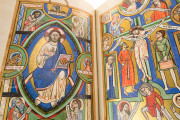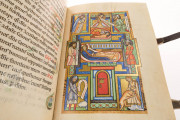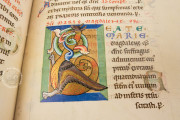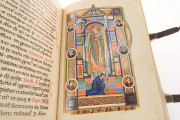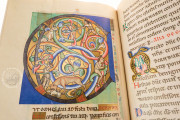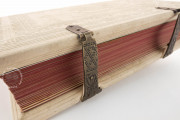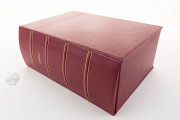With its vibrant and inventive illumination, the Stammheim Missal is one of the most splendid examples of German manuscript art of the twelfth century. It is a book comprising the prayers, chants, and selected readings of the Christian liturgy of the Mass arranged in annual cycles of the liturgical year. The manuscript was produced in the 1170s at the Benedictine monastery of Saint Michael's at Hildesheim in northern Germany. It is especially famous for its twelve full-page miniatures, many of which create unique visualizations of medieval Christian interpretation of scripture.
The manuscript dazzles on every page. In addition to the renowned miniatures, the book boasts ten large historiated initials and hundreds of decorated and inhabited initials. Each of the twelve calendar pages has a painted architectural surround and figural decoration. Twenty-nine pages present notated chant under pairs of painted arches on slender columns whose designs harmonize across facing pages.
Pictorial Exegesis
Typology profoundly informs the subjects of the missal's miniatures, and the book's picture cycle constitutes a major monument of typological art. Typology is the Christian method of scriptural interpretation whereby persons or events in the Hebrew Bible—the Christian Old Testament—are understood to be types that prefigure persons or events in the New Testament or in Church history.
The Christian understanding of salvation history unfolds in the missal's miniatures, starting with Creation (fol. 10v), extending to the Assumption of the Virgin (fol. 145v), and ending with a pair of arresting images of the monastery's patron saint, the archangel Michael, and founder, Saint Bernward of Hildesheim (fols. 152r and 156r).
Two Talented Illuminators
The miniatures are the work of one painter, with the calendar decoration and the painted arcades the work of a second artist. Their painting style—imperfectly termed Romanesque—practiced across Europe in the twelfth century. The colors are bright and boldly applied. Attention is given to conveying spiritual truth rather than naturalism. The most solemn holy figures are presented frontally, their eyes staring and transfixing the viewer's gaze.
To the Honor of Saint Bernward
The manuscript was made as the monks of Saint Michael's were preparing to nominate their founder, the bishop and renowned art patron Bernward (d. 1022), for canonization by the pope as a saint. It is the most dazzling of a trio of luxury manuscripts made in service of that cause. It was probably always intended more as a repository of the monastery's liturgy in honor of the founder than a book for use in the liturgy, a contributing factor in the manuscript's pristine state of preservation.
Four Scribes
The text was written by four scribes, all of whom wrote in the Transitional Script of the long twelfth century. Three of them also seem to have provided music notation. One may have been the monastery's cantor—the person responsible for organizing both liturgical services and the copying of books.
Ghost of an Original Treasure Binding
The seventeenth-century binding of blind-stamped white pigskin features a cavity carved out of the front board and accessible from the inside front cover. This was formerly home to a pair of carved ivory panels—probably once owned by Saint Bernward—that may have formed part of the exterior decoration of a previous treasure binding.
The manuscript came into the possession of Franz Egon, Freiherr von Fürstenberg and prince-bishop of Hildesheim, at the dissolution of the monasteries in 1803. It owes its nickname to the Fürstenberg family's palace, Schloß Stammheim, outside Cologne, where the manuscript was kept when scholars discovered it in the early twentieth century. The J. Paul Getty Museum purchased the book in 1997.
We have 1 facsimile edition of the manuscript "Stammheim Missal": Das Stammheimer Missale facsimile edition, published by Quaternio Verlag Luzern, 2019
Request Info / Price



